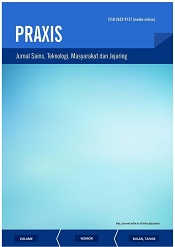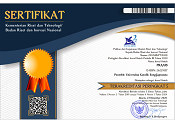Studi Deskriptif Literasi Mahasiswa Terkait Covid-19
Abstract
Melihat pandemi Covid-19 tidak akan segera berakhir, penelitian tentang Health Literacy terkait Covid-19 sangat mendesak untuk dilakukan dan hasilnya dapat dijadikan bahan pertimbangan untuk menemukan strategi terbaik untuk memutus rantai penyebaran Covid-19. Tujuan penelitian ini adalah mendeskripsikan literasi kesehatan mahasiswa yang seharusnya lebih tinggi dari kelompok sosial lainnya. Partisipan dalam penelitian ini adalah mahasiswa yang berada di Semarang yang berjumlah 913 mahasiswa. Peneliti menggunakan HLS-Covid-Q22 yang diadaptasi ke dalam bahasa Indonesia. Hasil dengan Chi Square menunjukkan perbedaan yang signifikan tentang literasi kesehatan antara siswa perempuan dan siswa laki-laki. Implikasi lebih lanjut dari temuan ini akan dibahas.
Keywords
Full Text:
PDF (Bahasa Indonesia)References
Altin, S. V., Finke, I., Kautz-Freimuth, S., and Stock, S. (2014). The evolution of Health Literacy assessment tools: a systematic review. BMC Public Health, 14: 1207 http://www.biomedcentral.com/1471-2458/14/1207
Clouston, S. A. P., Manganello, J. A., Richards, M. (2017). A life course approach to health literacy: the role of gender, educational attainment and lifetime cognitive capability. Age and Ageing.(46): 493–499 doi: 10.1093/ageing/afw229
Erunal, M., Ozkaya, B., Mert, H., dan Kucukguclu, O. (2018). Investigation of Health Literacy Levels of Nursing Students and Affecting Factors. International Journal of Caring Sciences. 11, 1386 – 1394.
Kutner, M., Greenberg, E., Jin, Y., & Paulsen, C. (2006). The Health Literacy of America’s Adults : Results From 2003 National Assesment of Adults Literacy. Washington, DC : National Center for Educatios Statistics
Lee, H. Y., Lee. J., & Kim, N.(2015) Gender Differences in Health Literacy Among Korean Adults : Do Women Have a Higher Level of Health Literacy Than Men?. American Journal of Men’s Health, 9 (5), 370-379
Lestari, P., and Handiyani, H. (2017). The higher level of health literacy among health students compared with nonhealth students. UI Proceeding HealthMed. Vol. 1
Nutbeam, D. (2015) Defining, Measuring, and Improving Health Literacy. HEP 42(2), 16-21.
Okan, O., Bollweg, T.M., Berens, E-M., Klaus Hurrelmann, K., Ullrich Bauer, U. and Schaeffer, D. (2020). Coronavirus-Related Health Literacy: A Cross-Sectional Study in Adults during the COVID-19 Infodemic in Germany. Int. J. Environ. Res. Public Health, 17, 1-20. , 5503; doi:10.3390/ijerph17155503
Paakkari , L. & Okan, O. (2020). Covid-19: Health Literacy is an Underestimated Problems. The Lancet. Com/public-health. 1-2
Sørensen, K., Van den Broucke, S., Pelikan, J., Fullam, J., Doyle, G., Slonska, Z Kondilis, B., Stoffels, V., Osborne, R. H., and Brand, H. (2013). Measuring Health Literacy in Populations: Illuminating the design and development process of the European Health Literacy Survey Questionnaire (HLS-EU-Q). BMC Public Health, 13(948)
Sukys, S., Cesnaitiene, V.J., and Ossowsky, Z,M. (2017). Is Health Education at University Associated with Students’ Health Literacy? Evidence from Cross-Sectional Study Applying HLS-EU-Q. Hindawi. Biomed Research International. 1-9
Utami, M. S. S., Rahayu, E., Parmitasari, D. L. N., dan Yudiati, E. A. (2019). Health Literacy. Semarang. Penerbit Unika Soegijapranata.
Wills, J., Sykes, S., Hardy, S., Kelly, M., Moorley, C., & Ocho., O. (2019). Gender and health literacy: men’s health beliefs and behaviour in Trinidad. Health Promotion International. 1–8. doi: 10.1093/heapro/daz0762
DOI: https://doi.org/10.24167/praxis.v3i2.3147
View My Stats | ISSN 2622-9137 (media online)







